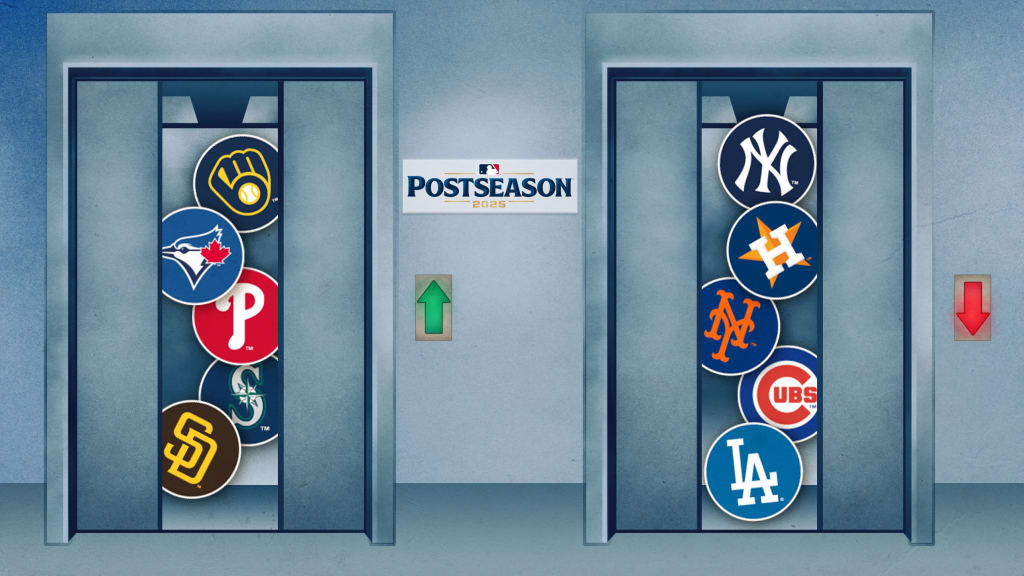
The past month has served as a reminder of how fast things can change in baseball, even at this point of the season.
Since the second half got underway on July 18 -- exactly one month ago Monday -- five of MLB’s six division races have shifted dramatically.
With help from FanGraphs’ division title odds, here’s a look at how each race has changed since the All-Star break ended.
All stats below, including odds, are through Sunday.
AL EAST
Biggest riser: Blue Jays, +42.5 (37.2% to 79.7%)
Biggest faller: Yankees, -30.4 (45.5% to 15.1%)
Before the break: The Yankees spent much of the first three months atop the AL East, but the division race began to shift in the second half of June, as the Bronx Bombers hit the skids. The Blue Jays pulled ahead of the Yankees on July 3 and went into the break with a two-game lead, though Toronto's +17 run differential at that point (compared to +111 for the Yanks) raised some questions about the team's staying power as a contender.
Since the break: The Blue Jays have solidified their standing as the top team in the division with the AL’s best record (18-11) since the All-Star break, powered by a lineup averaging more than six runs per game in the second half. The Yankees have played .500 baseball (14-14) in that same timeframe, falling further behind Toronto and even slipping behind the Red Sox. After taking two of three from both the Cubs and the Rangers this past week, the Blue Jays entered Monday with a five-game lead over the Red Sox and a 5 1/2-game advantage over the Yankees.
AL CENTRAL
Biggest riser: Tigers, +1.0 (96.6% to 97.6%)
Biggest faller: Twins, -2.1 (2.1% to 0.0%)
Before the break: The Tigers were the toast of the baseball world in the first half, posting MLB’s best record at 59-38 and sending six players to the All-Star Game, four of whom -- Tarik Skubal, Gleyber Torres, Riley Greene and Javier Báez -- started for the AL. With no other AL Central teams above .500, Detroit ended the first half leading the division by 11 1/2 games.
Since the break: With Detroit stumbling out of the break and the Guardians surging, Cleveland was able to cut its AL Central deficit down to five games going into Aug. 10. However, the Tigers’ division title odds never dropped below 91.5%, and they’ve started to add to their lead once again while winning six of their past eight games. Swept by the Braves over the weekend, the Guardians entered Monday 8 1/2 out.
AL WEST
Biggest riser: Mariners, +22.4 (23.3% to 45.7%)
Biggest faller: Astros, -20.2 (73.6% to 53.4%)
Before the break: After starting out 26-25, the Astros won 29 of their next 39 to build a healthy lead over the Mariners in the AL West. Houston had the third-shortest division title odds of any team at the end of the first half.
Since the break: With their injury problems continuing to pile up -- closer Josh Hader just became the latest Houston star to go down -- the Astros have struggled to a 13-15 record in the second half. Houston brought back Carlos Correa in a Trade Deadline stunner, but that move hasn’t been enough to lift the club out of its rough patch. Meanwhile, the Mariners added Eugenio Suárez and Josh Naylor before the Deadline and have compiled a 17-12 record since the break, tightening up the AL West race considerably.
NL EAST
Biggest riser: Phillies, +22.2 (58.1% to 80.3%)
Biggest faller: Mets, -21.9 (41.6% to 19.7%)
Before the break: Philadelphia entered the All-Star break with just a half-game edge over New York after the two clubs spent the first half passing the NL East lead back and forth.
Since the break: The Mets reclaimed the NL East lead during the course of a seven-game winning streak in late July, but it has been all Philadelphia lately, even when it comes to the flamethrowing relievers the two clubs added at the Trade Deadline -- Jhoan Duran (0.00 ERA, five saves with Phillies) and Ryan Helsley (0-3, 7.11 ERA with Mets). Going back to July 28, the Phillies have picked up 6 1/2 games on the Mets, who have gone just 4-14 in that time.
NL CENTRAL
Biggest riser: Brewers, +61.2 (31.8% to 93.0%)
Biggest faller: Cubs, -57.1 (64.1% to 7.0%)
Before the break: For almost the entire first half, first place in the NL Central belonged to the Cubs. Milwaukee, meanwhile, found itself in fourth place and 10 games behind Chicago after starting out the season 25-28. At that point, it was hard to imagine the Brewers would whittle the Cubs' lead down to one game by the All-Star break. But they did just that, posting an MLB-best 31-12 record in their final 43 games before the break.
Since the break: The All-Star break did nothing to slow the Brewers’ momentum. Milwaukee has continued to look like baseball’s best team, going 22-5 -- including a franchise-record 14-game winning streak -- with a +80 run differential in the second half. The Cubs, on the other hand, have played sub-.500 ball since the break while averaging just 3.78 runs scored per game, a steep dropoff from their stellar first-half mark (5.33). Chicago now sits eight games behind Milwaukee in the NL Central.
NL WEST
Biggest riser: Padres, +13.2 (2.7% to 15.9%)
Biggest faller: Dodgers, -10.1 (94.2% to 84.1%)
Before the break: The NL West remained highly competitive into mid-June before the Dodgers began to pull away, increasing their lead up to nine games by July 3. However, the cracks began to show for the defending World Series champions after that, and the Padres were able to cut the deficit back down to 5 1/2 games by the time the break rolled around.
Since the break: Emboldened by a huge Deadline that saw them add Mason Miller, Ryan O'Hearn, Ramón Laureano, Nestor Cortes and Freddy Fermin, the Padres have continued to put pressure on the Dodgers in the second half. San Diego was even able to pull ahead of Los Angeles briefly, though the Dodgers reclaimed their division lead with a three-game sweep over the Friars this past weekend. FanGraphs’ odds still consider the Dodgers to be heavy division favorites, but this one could go down to the wire.
